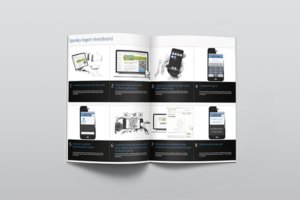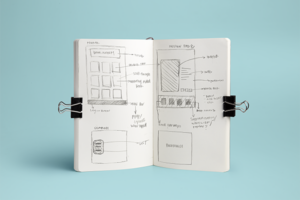UX
User Experience Design (UX & UCD)
We employ a customer-centric mobile-first design approach to all our UX processes. Our goal is to ensure that your products and services are easy to use, enjoyable, engaging, and inclusive.
Our four-step process allows us to dive deep into understanding your customers’ wants and needs, then together we devise intuitive ways to embed business objectives.
Discover (1)
Empathise, understand & explore the questions asked through Roadmaps, Market & User Research, Competitor & Gap Analysis, Analytics, Benchmarking, Heuristic Evaluation, and Requirement Gathering (brief). Read More
Strategise (2)
Define and brainstorm through Collaborative Workshops, Persona Creation, User Stories, Sketch Boards (KJ method), User Scenarios & Storyboards, Concept Sketching, SWOT Analysis, Value Position & Empathy Mapping, and UCD Canvas Creation. Read More
Design (3)
Ideate, Information Architecture (IA), Site Mapping, User Flows, User Journeys, Experience Mapping, Sketching (scamps & detailed), Wireflows, Wireframes, and Prototyping (low fidelity). Read More
Validate (4)
Test and refine, through Usability Testing (gorilla & sessions), A/B Testing, Analytics, Page Descriptions, and Functional Specifications. Read More
We don’t discriminate
Like getting to know your customers, we understand that each company is at a different level of UX maturity.
Because of this we tailor services that suit your taste and can offer full fat or lean UX services dependant on your pallette.
The Discovery Phase
Empathise, understand and exploration
Roadmaps
We develop UX roadmaps that strategically align priorities that communicate the UX team’s future work and problems to solve.
We frame the meaning and use of the UX roadmap by organising the context (scope and time) into themes. Once stakeholders and high-level goals have been defined in the scope themes are then added to the 3 horizon points Now, Next, and Future.
Themes are a good way of growing companies’ UX evolution by incorporating themes that fill in gaps in the UX processes.
Market & User Research (R&D)
Research forms the backbone of all our projects, understanding the market and empathising with the users’ wants and needs enables us to produce products that not only satisfy but convert.
Diving deep into your marketplace, we devise ways through brand storytelling to engage, excite, and encourage users to interact with your products and services.
Depending on your budget and timeframes User Researching session can be set up with the goal of understanding your customers, their pain points and desires. For lower budget projects Guerrilla testing and surveys are a helpful alternative.
Competitor & Gap Analysis
Jakob’s Law, Heuristic approach – Users spend most of their time on other sites. This means that users will prefer your site to work the same way as all the other sites they already know.
With this in mind looking into your competition to uncover what they are doing right and wrong helps with the discovery of opportunity gaps and threats affecting your business.
Analytics
Analytics and tracking are the most essential elements of successfully understanding your business. They highlight what users are actually doing with your product and where improvements are required. Usage data from marketing campaigns, engagement, dropoff, and conversions should all form a key part of the discovery and outcome phase.
G4 Analytics, Tag Manager, Search Console, Bing Webmaster, Social Media Tracking, Clarity, Crazyegg, Hotjar.
Benchmarking
A key area to the discovery phase is understanding where you are now, that way we can uncover where you want to get to and track the success of changes made. We measure key business metrics and practices by comparing them to competitor analysis, to understand how and where to improve performance.
Heuristic Evaluation
We offer a heuristic service that examines both new and existing interfaces and judges their compliance against recognised usability principles and indicators.
- Visibility of system status
- Match System + Real World
- User control & freedom
- Consistency and standards
- Error prevention
- Recognition rather than recall
- Flexibility & efficiency of use
- Aesthetic & minimalist design
- Help & Recover from error
- Help and documentation
Our 4 Indicators for severity are:
- Catastrophic Usability Error
- Major Usability Problems
- Aesthetic Issue
- Minor Usability Problems
The severity of a usability problem is a combination of three factors that affect the user:
- The frequency with which the problem occurs
- The impact of the problem if it occurs
- The persistence of the problem
Requirement Gathering
Information
The Strategy Phase
Define and brainstorm
Workshops
Workshops and brainstorming sessions are incredibly important when it comes to defining project strategy. We are familiar with both in-person and remote session organisation and hosting.
User Personas
Creating characters that clearly represent user types that use your site, brand, or product in a similar way.
User Stories
User-story maps help guide the planning and implementation of features and functionality to solve users’ problems (Product Focused) – Sketch, Figma.
Sketchboards & the KJ method
Generate, evaluate and refine User Interfaces through idea generation and prioritisation. Working with skeleton concept sketching it’s possible to explore and evaluate a range of interaction concepts that involve both business and technology partners. Sketchboards quickly performs iterations on many possible solutions and then singles out the best user experience to document and build upon.
User Scenarios & Storyboards
User Scenario templates – Sketch, Figma, and Miro.
Storyboards templates – Sketch, Figma, and Miro.
Storyboards developed for Barclays Bank.
Concept Sketching
Pencil sketch examples from previous project work.
SWOT Analysis
Discover your strengths, weaknesses, potential opportunities and threats via a detailed SWOT analysis.
Value Proposition & Empathy Mapping
Visualise and understand your end user – Sketch, Figma
UCD Canvas’
User-Centred Design Canvas and Design ModelCanvas – Sketch, Figma
The Design Phase
Ideate
Information Architecture
Information
Site Mapping
Information
User Journeys
Information
Experience Mapping
Information
Sketching
Information
Wire Flows
Information
Wireframes
Information
Prototyping
Information
The Validation
Test & Refine
Usability Testing
Information
A/B Testing
Information
Analytics
Information
Page Descriptions
Information
Functional Specification
Information
Evaluate & Iterate
Information
“We don’t work for you,
we work with you! Thats the ethos of Harambee“
Barnaby O’Connor – Founder Bwana Makubwa
Product Design
Our user experience services can be coupled with end-to-end visual design services delivering complete project design services.






















